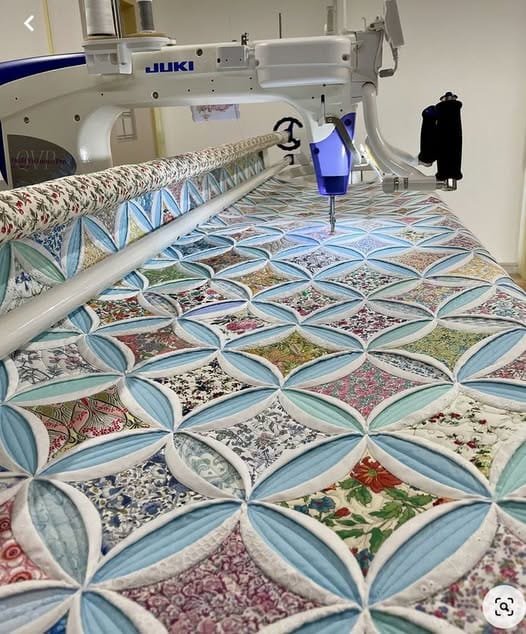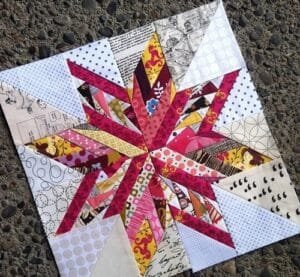The Cathedral Windows Quilt Pattern is one of the most fascinating and visually captivating designs in the quilting world. Known for its intricate appearance and elegant geometric layout, this pattern has captured the attention of quilters for generations.
One of the reasons the Cathedral Windows Quilt Pattern continues to inspire quilters is its unique construction. The quilt is built using squares that are folded and stitched in such a way that fabric “frames” are created around small windows of colorful cloth.
Another feature that makes the Cathedral Windows Quilt Pattern so appealing is its flexibility. Quilters can choose from a wide variety of fabrics and colors to create striking contrasts or subtle, harmonious designs.

History and Origins of the Cathedral Windows Quilt Pattern
The history of the Cathedral Windows Quilt Pattern is deeply rooted in tradition. While its exact origins are difficult to trace, it gained popularity in the United States during the twentieth century. Inspired by the beauty of stained-glass cathedral windows, quilters sought to recreate the effect using fabric. This pattern quickly became a symbol of creativity and craftsmanship within quilting circles.
Over the years, quilters have developed different methods for constructing this pattern, but the overall concept remains consistent. The folding and stitching process reflects the patience and dedication often associated with quilting traditions. This design was especially popular during times when scraps of fabric were reused, turning small remnants into breathtaking window “panes.” The idea of sustainability combined with artistry made the pattern beloved among resourceful crafters.
Today, the Cathedral Windows Quilt Pattern is seen as a bridge between past and present. While the folding techniques have not changed much, modern quilters often incorporate contemporary fabrics and innovative color schemes. This blend of history and modern style ensures the design remains relevant and appealing to every generation of quilters.
Techniques and Construction
The creation of the Cathedral Windows Quilt Pattern is very different from piecing together traditional patchwork blocks. Instead of cutting and sewing small pieces, quilters begin with squares of fabric that are folded and pressed into specific shapes. This folding process forms the framework of the “windows.” Once in place, contrasting fabric is inserted into the openings to create the stained-glass effect.
The base squares are usually made from solid fabrics, often in neutral tones like white or cream. These colors serve as the “frame” for the windows, allowing the colored inserts to shine. Each square is carefully folded diagonally and then stitched in a way that creates small arcs. These arcs form the edges of the windows, giving the quilt its three-dimensional appearance.
Precision is essential when working on this pattern. A slight misalignment can change the overall look of the windows, so quilters often take extra time during pressing and folding. Patience is the key. Although it may take longer than other quilting projects, many quilters find the process soothing and rewarding.
Another detail that makes this pattern unique is that it does not require batting in the traditional sense. Because of the way the squares are folded and layered, the quilt naturally gains thickness and weight. This gives the finished piece a textured and substantial feel without additional materials.
When choosing fabrics for the window inserts, quilters can experiment with bold prints, solids, or even batik fabrics. Each choice dramatically changes the overall look. Some quilters prefer high-contrast fabrics to highlight the window frames, while others use soft gradients for a more subtle design.
Ultimately, the Cathedral Windows Quilt Pattern gives quilters the chance to blend precision with artistic freedom. The folding and stitching must be exact, but the fabric choices allow for endless creativity.
Variations and Creative Ideas
One of the most exciting aspects of the Cathedral Windows Quilt Pattern is the wide range of variations available. While the traditional method is the most common, many quilters experiment with different techniques to adapt the pattern to their personal style.
Some variations focus on fabric choices. For instance, instead of neutral frames, quilters may use dark fabrics like navy or black, which can create a dramatic stained-glass effect. Others may choose to incorporate patterned fabrics into the frames for a playful twist.
Another variation is the scale of the windows. By adjusting the size of the squares, quilters can create larger or smaller windows. Larger windows make a bold statement and allow for more detailed fabric prints, while smaller windows create a more delicate and intricate design.
Creative quilters also experiment with color placement. A quilt with rainbow-colored windows arranged in a gradient can make a stunning piece. Others may design their windows to form secondary patterns, such as stars or geometric shapes, when viewed from a distance.
In addition to bed quilts, this pattern can be adapted into smaller projects. Table runners, pillow covers, and wall hangings are all popular uses of the Cathedral Windows Quilt Pattern. These smaller projects allow beginners to practice the folding technique without committing to a large quilt.
Modern technology has also influenced how this pattern is made. Some quilters use sewing machines to speed up certain steps, while others stay true to hand stitching for authenticity. Either method produces beautiful results, and the choice depends on personal preference.
The creative possibilities are endless, making this pattern a favorite among those who love experimenting and pushing traditional quilting boundaries.
Tips for Beginners
For those new to quilting, the Cathedral Windows Quilt Pattern can appear intimidating, but with the right approach, it becomes manageable and enjoyable.
The first tip is to start small. Instead of attempting a full-sized quilt right away, beginners should practice with a pillow cover or wall hanging. This gives them time to learn the folding and stitching process without becoming overwhelmed.
Another important tip is to use high-quality fabric. Since the squares are folded multiple times, thinner fabrics may wear out quickly. Medium-weight cotton is usually the best choice for both durability and ease of handling.
Patience is essential when working on this pattern. Taking the time to press folds carefully and align edges precisely will lead to better results. Rushing through the process often causes misaligned windows that take away from the beauty of the design.
Beginners should also consider using a limited color palette at first. Too many fabric choices can make the project confusing. Starting with a simple combination of frame fabric and one or two colors for the windows makes the learning process smoother.
Keeping tools organized is another helpful tip. A good iron, sharp scissors, and strong thread will make a noticeable difference in the quality of the final quilt. Investing in these tools ensures a more enjoyable quilting experience.
Finally, beginners should not be discouraged by mistakes. Each misaligned fold or uneven stitch is part of the learning journey. Over time, practice will lead to improvement, and the results will reflect dedication and effort.
FAQ
What makes the Cathedral Windows Quilt Pattern different from other quilt patterns?
This pattern stands out because it uses fabric folding instead of traditional patchwork. The folded fabric creates three-dimensional windows that resemble stained glass.
Do I need batting for a Cathedral Windows Quilt?
No, the quilt naturally gains thickness from the folded fabric layers, so batting is not typically required.
Is this pattern suitable for beginners?
Yes, but it requires patience. Beginners should start with small projects like a pillow cover before attempting a full quilt.
What fabrics work best for this pattern?
Medium-weight cotton is ideal. It is durable and easy to fold, making it perfect for the repeated pressing required in this design.
Can I make this quilt by machine, or should it be hand-stitched?
Both methods work. Some quilters prefer the authenticity of hand stitching, while others use a sewing machine to save time.
How long does it take to complete a Cathedral Windows Quilt?
The time varies depending on the size of the project and the quilter’s experience. Small items may take days, while full quilts can take weeks or even months.
Conclusion
The Cathedral Windows Quilt Pattern is a timeless design that combines tradition, creativity, and craftsmanship. From its fascinating history to its unique folding techniques, this quilt offers a rewarding challenge for both beginners and experienced quilters. Its versatility allows for endless creativity, whether making a bedspread, wall hanging, or decorative piece.
If you are considering your next quilting project, this pattern is a wonderful way to explore new skills while creating something truly unique. Take your time, experiment with fabrics, and enjoy the process of watching the windows take shape.



